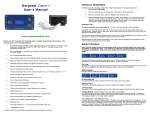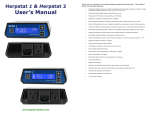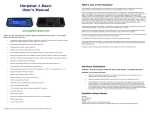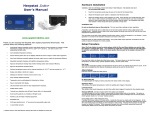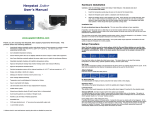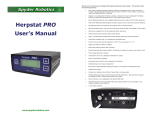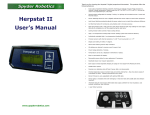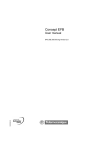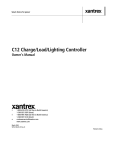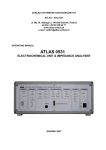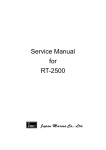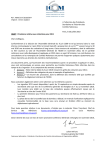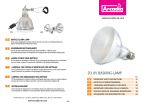Download Herpstat 4 User`s Manual
Transcript
Thank you for choosing the Herpstat 4 digital proportional thermostat. This product offers the following features: Herpstat 4 (Version 2) User’s Manual www.spyderrobotics.com • Four output proportional heating constantly monitors and adjusts amount of heat necessary to maintain a target temperature (usable range from 40˚F to 150˚F or 4˚C to 65˚C). • Outputs 1 & 2 configurable for Heating/Cooling/Lighting. Outputs 3 & 4 can be configured for Heating /Cooling/Humidity/Lighting with simulated sunrise/sunset and moonlight features. • User selectable temperature and light ramping. • Sensor Matching allows the user to digitally calibrate the sensor output to match other equipment. • Auto Power Matching constantly adjusts the power output curve to match the enclosures efficiency. • MaxPwr option lets user control the maximum amount of power applied to the heating device which can increase safety as well as provide softer temperature ramps. • Basking assist feature supports basking lights as a heat source. • Individually selectable day/night schedules with nighttime temperature settings for each output. • High/Low temperature tracking helps monitor heating system and enclosure efficiency. • Individually selectable High/Low temperature threshold alarms. • Precision temperature sensors with an internal resolution of .1125 ˚F and are accurate to ± .9 ˚F • Display and setting in tenths of a degree. • Security Passcode option deters vandals. • All settings are retained in memory even if power is lost. • Power Outage detection/tracking. • Temperature can be set/displayed in Fahrenheit or Celsius. • Easy to read backlit LCD display. • Removable sensors allow for easy replacement if necessary. • Each output is fused separately keeping an outage on one output from affecting the other. • Audible alarm system • Internal error detection shuts off heat if sensor fails or is disconnected. • Internal safety relay can be configured to disable power to all outputs if user settable conditions are met. • External input can be used to trigger events such as turning off a mist pump when the water supply is low. • 400 watt rating for each output (1600 watts total output) is sufficient for most incubators, rack systems, enclosures, and vivariums. • 1 year limited warranty What's new in this Herpstat? The Herpstat line of thermostats has a reputation as the most reliable and user customizable thermostats geared directly towards the reptile industry. Here are some of the great features: A new revolutionary way of controlling the temperature has been implemented. Most thermostats apply full power when plugged up. However, this is not always ideal. For example, if your power goes out and you have eggs in a incubator. When the power comes back on, the heat element (typically at the bottom of the incubator) turns full on and the eggs on bottom can be subjected to the immediate heat. The Herpstat 4 now has a "soft power" state that will slowly advance the power a single percent around every second or so. If the temp seems to be rising too quickly (a tenth of a degree per loop) it will stop or back off a percent. There is also a completely new routine that will figure out the best power output curve in the last two degrees before the target temp. This allows the Herpstat 4 much better control for some of the weaker heating devices as well as overpowering ones. This is all automatic and requires no settings to enable. Hardware Installation WARNING – FIRE OR ELECTRICAL SHOCK MAY RESULT FROM MISUSE. FOR INDOOR USE ONLY! Do not exceed 400 watts per output. 1. Each AC receptacle on the Herpstat 4 has a corresponding probe jack under it. For heating or cooling use attach a temperature probe. For humidity control an optional humidity sensor can be connected (#3 and #4 probe jacks only). For lighting control or for a disabled output the probe jack can be left empty. 2. Attach the Herpstat 4 power plug to a standard wall outlet. 3. After setting the correct mode of operation in the menu attach the appropriate devices to the AC outlet receptacles. These devices may include heat tape, heat coils, mats or other resistive load heating devices. Not recommended for use with rock heating devices or other devices that come in direct contact with the animal. In cooling mode the outlets can be used for emergency fans. For controlled lighting incandescent lamps and some transformerless LED lamps can be used. Misting pumps and foggers can be used for humidity control. Do not connect oil-filled heaters, space heaters. 4. The external input jack is used to connect an optional cable and switch. This can be used to trigger events and alarms such as disabling a misting pump to prevent operation when the water supply is depleted. This is used only for a non-powered switch. Any power input though this connection can cause damage to the unit. Any 3.5mm mono audio plug and cable can be used with a switch for this function and can be obtained from your local electronics store. The switch can be normally open or normally closed. The setup of the external input function can be changed to accommodate it. A user adjustable MaxPwr option can be used to limit the amount of power to a heating device. This can add additional safety by limiting how hot a heating device can get if a probe is dislodged. Can also be used to make sure heating element doesn't get too hot during ramp up which is a great feature for incubators. User's now have two proportional control modes both with 100 steps of resolution. Smooth dimming proportional mode which is used for most applications and now also pulse proportional mode specifically for metal rack systems. On some metal rack systems dimming style proportional can generate a audible hum in the rack. Pulse style proportional can help eliminate the hum while still providing varied power to the heating device. Larger more efficient heatsinks allow quiet fanless operation. Temperature ramping has been added. The Herpstat 4 can slowly ramp up and down between the day and night time temperature settings. The amount of time is user selectable up to 10 hours. Lighting control ramping was also added. Using this feature can more closely mimic natural lighting. We also added a fully user adjustable nighttime power setting which can be used to mimic moonlight. Safety has been enhanced by adding a mechanical relay to the power circuit. If enabled by the user, this relay can remove power to all four outputs during an error or High/Low condition. Adding this to the audible alarms, cooling fan, replaceable fuses, and error detection code makes this unit very safe. Available Modes: Humidity control is now available. Two of the outputs can be used to connect foggers, misting pumps, and other humidity devices. The Herpstat 4 can work with these in a time-based fashion right out of the box. Optional humidity sensors can be purchased to allow full control with humidity sensing capabilities. Output #1 & #2 Output #3 & #4 Disabled Includes all functions of #1 and #2 PLUS Heat (Dimming Mode) Humidity Scheduled Heat (Pulse Mode) Humidity Sensed (optional humidity sensor needed) Non-Proportional (Cooling) Humidity Hybrid (optional humidity sensor needed) Lighting (ON/OFF style for fluorescents) Lighting (Dimming style for incandescent and some transformerless LED lights) An external input jack was added. This jack can be used to trigger different events such as turning off a mist pump when the water supply has been depleted. Installation Tips: The High/Low temperature tracking now keeps track of the time and date when it was recorded. This helps identify when the peaks are happening and can help fine tune the environment. LCD backlight dimming has been added. The brightness is adjustable in the menu system. An updated menu design makes it even easier to adjust the settings. Grounded outlets (3-prong plugs) were added to accommodate more types of heating devices. Basking assist feature added supports basking lights as a heat source. Typically a proportional thermostat reduces power when the temperature is close to the target temp and turns off when the target temperature is breached. This causes a strobing effect when using basking lights. Basking assist will provide a small amount of power during regulation up to a degree above the target temp to prevent this. Do not use aluminum tape on the probe tip. This will cause false readings and poor regulation. If possible route the probe wires so that they are not in direct contact with the 120vac cables going to the heating devices. Preferably leave at least a few inches between the probe wires and the AC lines to avoid cross talk/electrical interference issues. Do not block the vents or impede airflow to the bottom of the Herpstat 4. Vent holes on the bottom of the device provide proper cooling. When choosing the type of switch to use with the external input keep in mind that the default state of the external input jack is "Open" if no cord is attached. This may be important for your setup should the cable ever be accidentally unplugged. Setup Procedure Note: The Enter button is used to select options while the Plus and Minus buttons are used to alter the options or navigate the menu. If no selection is made after a period of time the unit will return to operation automatically. While in the menu system all AC power to the outputs is turned off for safety. (Output Setup for Temperature Control continued...) DayTemp: The DayTemp setting is the temperature the device will try to maintain during the Day Cycle. If the Nite Cycle is disabled then the Day Temp setting will be used for the full 24hrs. SnsrAdj: The SnsrAdj (Sensor Adjust) setting is used to alter the temperature read by the temperature probe to match other equipment. Note: The sensor used in the Herpstat Probes are typically more accurate than most other equipment. Adjustments to this setting are usually not necessary. MaxPwr: This setting is available only in Heating mode. This controls the maximum power level that will be sent to the heating device. Press the Enter button to display the initial menu screen. This screen allows you to select which Output to configure, the System settings, and the Hardware settings. Each output has its own individual settings. All settings in the unit are stored in non-volatile eeprom memory which are retained during a power outage. Swing: This setting is available in Cooling mode. This controls the range of temperature before the output is re-enabled after it has made it to the Day Temp or NiteTemp setting. Navigate to the System option and press Enter. Basking Assist: The Basking Assist option is for use with basking lights as a heat source. Once the target temperature has been reached instead of turning the power off it will continue providing a reduced power up to a degree above the target temperature. System Setup NiteCycle Menu: Enter this menu to adjust settings if a different temperature is required during the night. Note: Adjust the Time and Date to insure proper operation. Display: This setting adjusts whether to display temperature in Celsius or Fahrenheit. SetTime: This setting adjusts the system clock's time. While setting the time the Plus button increments the hour and the Minus button increments the minute. SetDate: This setting adjusts the system clock's date. While setting the date use the Plus and Minus buttons to adjust the setting and the Enter button to advanced to the next setting. Sounds: Enables or disabled the system beep during menu selection. Does not affect audible alerts. M-Reset: (Master Reset) Selecting this will reset all settings in the device to factory defaults. LCD: This option will adjust the LCD backlight brightness. NC= (OFF / ON) To Enable/Disable the Nite Cycle press the Enter button while the cursor has the NC= option selected. Nite Temp: This setting is the temperature the device will maintain during the Nite Cycle. NC Start: This setting adjusts what time the Nite Cycle starts. NC End: This setting adjusts what time the Nite Cycle ends. Ramping: This setting adjusts how long it will take to switch between the DayTemp and NiteTemp settings allowing a smooth transition up to 10 hours. H/L Alarm Menu: Enter this menu to set the audible High/Low Alarm feature. Output Setup for Temperature Control From the initial menu screen select an output using the Plus and Minus button and press Enter. H/L Alarm= (OFF / ON) To Enable/Disable the High/Low Alarms press the Enter button while the cursor has the H/L Alarm= option selected. Mode: (Heat (Dimming), Heat (Pulse), Cooling) Note: When the Mode is changed all settings for selected output will be set to the defaults for that particular mode. Heat (Dimming) can adjust the voltage output to the heating device similar to a household dimmer. In most cases this is the best performing mode of control. Heat (Pulse) can provide varied lengths of pulsed power to the heating device. This method of control is best used with metal rack systems. The Cooling mode is a non-proportional mode that applies power when the set temperature is breached. The Cooling mode then powers off the output when the temp drops below the Swing setting. H-Alarm: This setting is the highest temperature at which the audible alarm triggers if breached for the selected output. L-Alarm: This setting is the lowest temperature at which the audible alarm triggers if breached for the selected output. L-Alarm 30m Mute: This setting is under the L-Alarm menu. By default it is enabled. This will mute the low temperature alarm for 30 minutes when the Herpstat first powers on or returns from the menu allowing time for the temperature to reach the target setting. If the L-Alarm is triggered you can reactivate the mute by entering the menu or by pressing the PLUS button on the main display that shows the probe temperatures. This will allow another 30 minutes before the L-Alarm becomes active. Output Setup for Lighting Control From the initial menu screen select an output using the Plus and Minus button and press Enter. (Output Setup for Humidity Control continued...) RH % Note: Only available in Humidity Sensed or Humidity Hybrid modes. This setting adjusts the highest level of relative humidity. Once this amount has been breached the power will shut off to the output. Schedule Menu: Enter this menu to set the scheduled times to activate a humidity session. Note: Only available in Humidity Scheduled or Humidity Hybrid modes. Mode: ( Lighting (ON/OFF), Lighting (Dimming) ) Note: When the Mode is changed all settings for selected output will be set to the defaults for that particular mode. Select the Mode option and set it to either Lighting (ON/OFF) or Lighting (Dimming). The ON/OFF mode will switch the output fully on or off and is used for fluorescent lighting. Dimming mode can be use with incandescent lights and many types of transformerless LED lighting and can adjust the power going to the lights to provide simulated sunrise, sunsets, and moonlighting. DayLite: This setting adjusts the amount of power applied during the Day Cycle. NiteCycle Menu: Enter this menu to adjust settings if a different light output is required during the night. NC= (OFF / ON) To Enable/Disable the Nite Cycle press the Enter button while the cursor has the NC= option selected. In this menu use the Plus and Minus buttons to navigate through the available slots. Advancing through all of the slots will bring you to the [BACK] option. Press Enter to switch to Editing Mode. In the Editing Mode the Plus button advances the hour and the Minus button advances the minute. To disable the slot advanced the hour until Disabled shows as the time. Once in the Editing Mode the Enter button is used to accept the change. When the Herpstat 4 is set to Humidity Hybrid mode the 9th scheduled slot is a "Forced Session" and if activated it will not check the sensor for feedback. This is useful if the humidity in the enclosure generally stays high but you want to make sure it activates at least once for feeding purposes. H/L Alarm Menu: Enter this menu to set the audible High/Low Alarm feature. NiteLite: This setting adjusts the amount of power applied during the Nite Cycle. H/L Alarm= (OFF / ON) To Enable/Disable the High/Low alarm press the Enter button while the cursor has the H/L Alarm= option selected. NC Start: This setting adjusts what time the Nite Cycle starts. H-Alarm: This setting is the highest humidity level at which the audible alarm triggers if breached for the selected output. NC End: This setting adjusts what time the Nite Cycle ends. L-Alarm: This setting is the lowest humidity level at which the audible alarm triggers if breached for the selected output. Ramping: This setting adjusts how long it will take to switch between the DayLite and NiteLite settings allowing a smooth transition up to 10 hours. SnsrAdj: The SnsrAdj (Sensor Adjust) setting is used to alter the humidity level read by the humidity probe to match other equipment. Note: The sensor used in the Herpstat Humidity Probes are typically more accurate than most other equipment. Adjustments to this setting are usually not necessary initially. However, over time any humidity sensor can drift and may need to be replaced and should be thought of as a consumable product. Accuracy can be tested with a Humidipak® pouch and then adjust this setting to match the difference. Output Setup for Humidity Control (Output #3 & #4 only) From the initial menu screen select an output using the Plus and Minus button and press Enter. Mode: ( Humidity Scheduled, Humidity Sensed, Humidity Hybrid ) Note: When the Mode is changed all settings for selected output will be set to the defaults for that particular mode. Humidity Sensed and Humidity Hybrid require the optional Herpstat Humidity Sensor sold seperately. Select the Mode option and set it to either Humidity Scheduled, Humidity Sensed, or Humidity Hybrid. Humidity Scheduled can be used to set up to nine separate scheduled times when a humidity device will power up and does not require a sensor. Humidity Sensed has no scheduled times and uses sensor feedback to determine if a humidity device will power up. Humidity Hybrid mode combines the two and you can select up to eight scheduled times when a humidity device will power up. Then during that session it checks the sensor and if the humidity level is below the RH setting then it will activate the output and if the level is above the RH setting the power will not be applied. Swing: This setting controls the range of humidity before the output is re-enabled after it has made it to the RH% level. For example: If the RH% level is set to 80% and the Swing is set to 5% the output will be powered until the humidity level reaches 80%. The output will then shut off and not power back on until the humidity level has dropped 5% (Swing). Duration: Note: Only available in Humidity Scheduled or Humidity Hybrid modes. This setting is the length of time the output will be powered during a humidity session. In Hybrid mode the power will be shut off if the humidity exceeds the setting in the RH% menu. Security Setup (Hardware Setup continued...) From the initial menu screen select Security using the Plus and Minus button and press Enter. Safety: This setting determines what course of action will take place during an error condition. This also controls the built in safety relay. Once the error condition is corrected the device will return to normal operations. Options: This setting creates a 4-digit Passcode that is required to be entered before menu access is granted. Use the Plus and Minus buttons to toggle the individual digit and the Enter button to advance to the next digit. Entering all zero's will disable the Passcode. If the menu timeout expires while in this setting the Passcode will be disabled automatically. If you forget this Passcode in order to regain access to the menu requires the device to be reset to factory defaults. This can be done by holding down the Plus button while plugging the Herpstat 4 into power. All settings are lost in this process. Hardware Setup (menu option) From the initial menu screen select Hardware using the Plus and Minus button and press Enter. INDIVIDUAL OUTPUTS: Excludes High / Low This option is the default setting and does not enable the built in safety relay. During an error condition it turns off the output that has the error. High/Low alarms will not shut off the output. INDIVIDUAL OUTPUTS: Includes High / Low This option does not enable the built in safety relay. During an error condition it turns off the output that has the error. High/Low alarms will shut off the output. ALL OUTPUTS IF: Any Error This option enables the built in safety relay. If any error condition occurs all outputs will be turned off and the safety relay is triggered, which cuts the main power to all the outputs. ALL OUTPUTS IF: High/Low Error This option enables the built in safety relay. If any High/Low alarm condition is set and is breached all outputs will be turned off and the safety relay is triggered, which cuts the main power to all the outputs. ALL OUTPUTS IF: Low Alarm Error This option enables the built in safety relay. If any Low alarm condition is set and is breached all outputs will be turned off and the safety relay is triggered, which cuts the main power to all the outputs. ALL OUTPUTS IF: High Alarm Error This option enables the built in safety relay. If any High alarm condition is set and is breached all outputs will be turned off and the safety relay is triggered, which cuts the main power to all the outputs. Test HW: This option will run through a hardware test. Incandescent lamps should be plugged into the outputs to verify power is being turned on and off. The unit will briefly turn on and off each output while displaying which output its working with on the lcd. Check to make sure the corresponding lamp turns on and off. The next test will check to make sure the internal clock is advancing properly. Should it fail any of these, contact support and stop using the device. The Display In normal operation the Minus button will toggle between the available display while the Plus button will activate special features of that display. Then the Enter button will activate the menu system. ExtInp Menu: Enter this menu to Enable/Disable the External Input and select the action to take place. The External Input is designed to attach to a non-powered switch wired by the user. It uses a standard 3.5mm mono plug. Trigger: This setting determines what type of trigger will activate the External Input event. In OPEN Contact mode the event will trigger if a switch is in its open state (not conducting). In Closed Contact mode the event will trigger if a switch is in its closed state (conducting). While in this setting the Herpstat 4 will display the current status of the External Input to help you choose. Action: This setting determines what action will take place when the External Input event gets triggered. Options: Audible Alarm This option will provide a audible alarm every few seconds during an External Input event. Temperature / Humidity Probe Status & Power Output This display shows the current temperatures and humidity levels from attached probes. It will also indicate if an output is disabled or set to lighting mode. For each output it will show the amount of power being applied. If an error occurs a description will be shown instead of the output information. The setting the device is trying to achieve is in parentheses. When ramping is enabled for temperature the value in parentheses will change according to the time based curve. Special Symbols: Next to the number of the output an arrow symbol will appear if that output is currently in a ramping session. A right arrow (→) will appear if the ramp is increasing. A left arrow (←) will appear if the ramp is decreasing. Next to the number of the output a minus sign (-) will appear if a Low Alarm has been breached. A plus sign (+) will appear if a High Alarm has been breached. Alarm & Shutdown This option will provide a audible alarm every few seconds and power off all outputs and activate the safety relay during a External Input event. Power OFF Output 3 Only Power ON Output 3 Only Power OFF Output 4 Only Power ON Output 4 Only Power OFF Output 3&4 Only Power ON Output 3&4 Only These options turn ON/OFF the #3 & #4 outputs which can be used to keep misting pumps from running dry, powering an alarm, etc. High Low Status This display indicates the highest and lowest temperature/humidity level recorded for the probe and the time at which it was recorded. Pressing the + button will reset the High/Low to the current reading. (The Display continued...) System Information This display indicates the internal clock's current time and the Power Outage. Each time the Herpstat 4 is powered on it increments the Power Outage Monitor. To reset the monitor to zero press the + button. Getting Help Questions or comments can be e-mailed to: [email protected] To purchase accessories please visit us on the web at: http://www.spyderrobotics.com This display indicates the current time schedule each output is adhering to. If the NiteCycle is disabled on the output it will always show Day Cycle. If an output's mode is set to disabled then it will also show disabled here. This display will only be available if one of the humidity modes is enabled. If the mode is set to Humidity Scheduled or Hybrid then pressing the Plus button will schedule a humidity session once the internal clock gets to the following minute. When the mode is set to Humidity Sensed then pressing the Plus button will power on the output. This type of forced session has an automatic timeout but should be canceled by the user and not left unattended. After initiating a forced humidity session pressing the Plus button a second time will end/cancel the session. This display will only be available if one of the lighting modes is enabled. If the Plus button is pressed it will turn on the outputs set to lighting. Pressing the Plus button a second time will return the lights to their previous state. Getting the most out of your Herpstat 4 (Troubleshooting) When setting up a new environment allow a minimum of one hour for the temperature to stabilize. Keep in mind that all items in the enclosure are warming up including the enclosure walls. Probe placement will require experimentation to achieve proper temperature regulation. If after an hour of initial regulation the temperature does not reach within a degree of the target temperature this is an indication of insufficient heating source. Add an additional heat device to the enclosure or switch to a higher wattage heat device. Do not exceed 400 watts per output. The Herpstat 4 has standard 5mmx20mm fuses with a rating of 3.5 amps. Should it appear that one of the outputs is no longer providing power the fuse for that output may need to be replaced. To do this unplug all cables from the back of the unit including power. Remove the two screws at the bottom of the unit. Gently lift and remove the top half of the case. On the circuit board there are 4 fuse holders each in front of the corresponding outlet. Some models may have a clear case over the top of the fuse holder. The clear case typically lifts straight off. Remove the fuse from the fuse clips and replace with a new fuse. Do not use any fuse with a rating higher than 3.5 amps. Reassemble the unit and test that the outputs are working properly before putting back into service. Should the device not work as expected it's possible one of the menu settings was set incorrectly. It may be easier to reset the device to its factory default settings than to figure out which setting is causing the issue. To do this hold down the Plus button while applying power to the Herpstat. Once the display reads Loading Defaults release the button. Do not use aluminum tape on the probe tip. This will cause false readings and poor regulation. If possible route the probe wires so that they are not in direct contact with the 120vac cables going to the heating devices. Preferably leave at least a few inches between the probe wires and the AC lines to avoid cross talk/electrical interference issues. 1 Year Limited Warranty Spyder Robotics warrants this product to be free from defects in workmanship and material for a period of one year from the date of purchase by the original purchaser. The warranty period shall not extend beyond 3 years from the date Spyder Robotics shipped the product. During this warranty period Spyder Robotics will repair or replace, at its option, any component parts that in its opinion prove to be defective. Replacement parts may be new or serviceable used parts at Spyder Robotics option, of equal or better quality to those being replaced. This warranty does not extend and shall not apply to products that have been subjected to misuse, neglect, accident, or improper installation. THIS LIMITED WARRANTY AND REMEDY ARE EXCLUSIVE AND EXPRESSLY IN LIEU OF ALL OTHER WARRANTIES EXPRESSED OR IMPLIED, INCLUDING BUT NOT LIMITED TO ANY IMPLIED WARRANTIES OF MECHANTABILITY AND FITNESS FOR A PARTICULAR PURPOSE. IN NO EVENT SHALL SPYDER ROBOTICS BE LIABLE FOR LOST PROFITS, LOSS OF GOODWILL, OR ANY OTHER INCIDENTAL OR CONSEQUENTIAL DAMAGES. If you return your product to Spyder Robotics for warranty service, proof of purchase may be required. A Return Material Authorization (RMA) number must be obtained prior to the return. Spyder Robotics is not responsible for material returned without the RMA number clearly printed on the outside of the shipping container. To request an RMA number, contact Spyder Robotics with the description of failure, serial number of device, and date of purchase via e-mail at [email protected]. ©2011 Spyder Robotics http://www.spyderrobotics.com manual-HS213 11.4.2015






